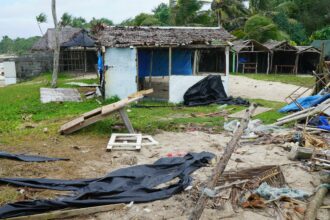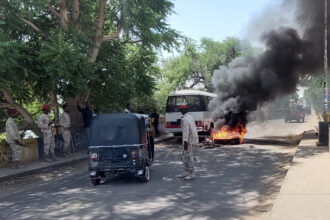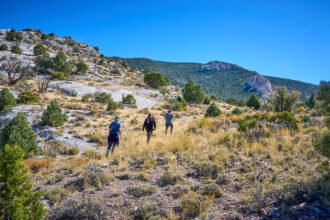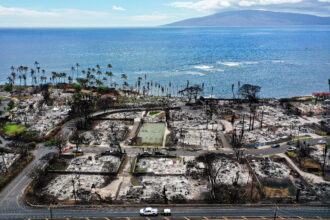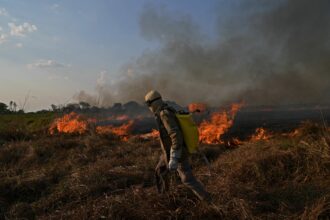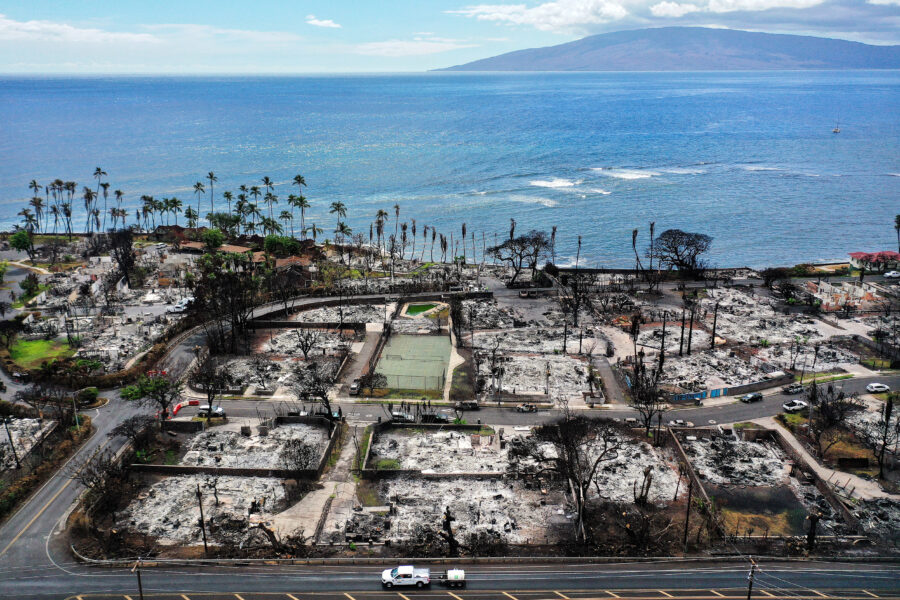Climate negotiators from rich, industrialized nations and poor countries devastated by global warming are starting one last make-or-break meeting Friday to finalize plans for a new fund to help developing countries pay for climate-related losses and damages that they have done very little to cause. The stalemate thus far in the negotiations shows there is still a wide gap between the climate aid developed countries have long promised and what they are ready to deliver.
Climate policy analysts said a failure to reach an agreement could undermine the COP28 global climate talks being held from Nov. 30 to Dec. 12 in Dubai by eroding what little trust developing countries have toward developed countries.
Loss and damage is a technical United Nations umbrella term for arrangements to cover the cost of permanent and irreversible climate impacts that can’t be mitigated or adapted to. It was first formally mentioned in 2007 at COP13, and grew out of Article 4 in the 1992 United Nations Framework Convention on Climate Change, in which developed countries made a commitment to “assist developing country Parties that are particularly vulnerable to adverse effects of climate change … by providing new and additional financial resources.”
Loss and damage includes impacts like the permanent loss of lands and homes to sea level rise, the costs of rebuilding infrastructure damaged by flooding and the loss of revenue from agricultural crops destroyed due to drought. Globally, climate economists say the measurable annual cost to developing nations will reach an estimated $400 billion by 2030, and soar above $1 trillion by 2050.
In some smaller developing countries, the costs are staggering. The World Bank, for example, estimated that when Tropical Storm Erika hit Dominica in 2015, it wiped out economic assets worth $483 billion, equal to about 90 percent of the country’s gross domestic product, a scale of loss that’s hard to recover from without outside help.
Article 8 of the 2015 Paris climate agreement reaffirmed the importance of addressing loss and damage as a key piece in the global deal to limit warming. Crucially, it decoupled any potential loss and damage payments from liability or compensation at the insistence of developed countries, which fear being on a legal hook for untold billions of dollars of loss, damage and suffering already caused by their emissions.
At COP27 in Egypt last year, the 196 countries of the UNFCCC finally agreed to establish a loss and damage fund, tasking a transitional committee with 14 members from developing countries and 10 members from developed countries to put together specific recommendations for approval at COP28. A similar committee was established in 2011 to map out the Green Climate Fund, which has mobilized $13.5 billion for investments in low-emission and climate-resilient development.
But the loss and damage committee hasn’t been able to agree on key details of the plan, including whether it should be hosted by the World Bank or set up as a U.N.-affiliated entity; which countries will pay into the fund and which are eligible to receive funding.
As currently envisioned, loss and damage funding is completely voluntary, with the amount in the fund dependent on what developed countries are willing to contribute. There will be periodic reviews to assess whether the funding is keeping pace with the spiralling cost of climate impacts, similar to the voluntary emissions cuts pledges made under the Paris Agreement.
A Climate Framework Designed to Endure Disagreements
That the transitional loss and damage committee didn’t find consensus by the end of the originally scheduled meetings in late October has been just one recent disappointing result from recent COP initiatives. In 2021, at COP26 in Glasgow, global leaders pledged to stop global deforestation, which is critical to reducing atmospheric carbon dioxide concentrations, but loss of forest cover increased 4 percent the following year. The Glasgow summit also saw 100 countries pledge to cut methane emissions 30 percent by 2030, but since then, methane in the atmosphere has surged to a record-high level.
Most countries are even falling short of their basic 2015 pledges to cut emissions enough to prevent the planet’s fever from spiking out of control, and the United Nations Environmental Program Adaptation Gap report released Nov. 2 showed that global efforts to fund climate change adaptation are falling farther behind. That fund is important in the context of loss and damage because every dollar not spent on adaptation now leads to more costly losses and damages later.
Still, some experts point out the fact that climate diplomats will have another chance to find common ground before the crucial global climate summit opens later this month shows the flexibility and institutional continuity of the U.N.’s climate process. As the COP28 host country, the United Arab Emirates took over the responsibility for hosting the loss and damage committee under the framework, including providing a venue and logistical and technical support.
It’s hard to imagine countries with such divergent interests continuing to talk about a fraught topic like payments for climate damages outside the U.N.’s climate governance framework, they note, because there is little incentive for individual countries to act on a problem that requires a global resolution.
The Paris Agreement, in particular, is designed to be flexible, acknowledging that national and international political and social constellations will shift during the decades of concerted global action required to stabilize the climate.
The best example came when former U.S. President Donald Trump in June 2017 announced he would pull the country out of the agreement, triggering a withdrawal period in the framework that outlasted his presidency, which enabled incoming President Biden to easily reverse Trump’s decision. Meanwhile, the rest of the world, more or less, continued working toward the agreement’s goals, and U.S. climate negotiators remained engaged, though partially sidelined, in the annual talks.
But the flexibility has been tested since 2015, as global political and social tensions have intensified. Right-wing nationalist governments in some key countries like Italy are questioning global climate goals and policies and, in some cases, backsliding on them. Russia’s invasion of Ukraine shows the close links between conflicts and energy policy, and the Israel-Hamas war has the potential to disrupt the coming COP 28.
Additionally, climate impacts are forcing growing numbers of people to try and migrate to safe havens, and the rise of of environmental protests involving civil disobedience have triggered a harsh legal backlash in some countries like Germany, where young climate activists were held in preventive custody for weeks because of their stated intent to blockade roads.
Through all that, 196 countries have still met every year to try and advance climate action, but the final outcome of the loss and damage discussions will still be a test of whether the U.N. climate process can deliver on any of its big promises.
Countries Argue Over Where to Host the Loss and Damage Fund
In a cycle that’s now familiar, the euphoria of reaching a major climate agreement at COP27 was replaced by frustration when the fourth meeting of the loss and damage committee ended without reaching its goal of crafting a clear-cut plan for the loss and damage fund. Some negotiators said the talks lacked a spirit of collaboration.
“I am just missing the enthusiasm,” Ali Waqas Malik, Pakistan’s representative on the committee, said during the closing session. “We celebrated in Sharm El-Sheikh when this was adopted and we were given a mandate to operationalize the fund in one year,” he said, adding that the fund was created against the backdrop of the catastrophic 2022 floods in Pakistan that killed thousands of people and displaced millions more.
“Innocent lives perished, and what message will I take back home when they say that you were sent to operationalize the fund and you came back empty handed?” he said. “There is nothing on the table, no equity.”
One of the biggest stumbling blocks has been a disagreement between developing and developed countries about where to establish the fund. Negotiators for developed countries said the World Bank has the global presence, infrastructure and legal capacity to get the fund up and running as quickly as envisioned, said Preety Bhandari, who observed the recent loss and damage transitional committee talks as a climate policy analyst with the World Resources Institute, a nonprofit global climate think tank based in Washington, D.C.
“It’s obvious that developed countries see the World Bank as a trusted institution, in which they have significant shareholding and decision making power,” she said.
But developing countries do not share that trust. They want the fund to be established as an independent legal entity under the authority of the UNFCCC, and not bound by the World Bank’s ways of doing business, she said.
“With a standalone option and under the authority of the UNFCCC, they have more say in providing guidance and reviewing the operations of the new fund,” she said. “They also have concerns that not all developing countries are eligible to get funding from the World Bank, as well as concerns about potentially high fees that might have to be paid to the World Bank for hosting the fund.”
Many developing countries worry that World Bank lending policies could increase the often crushing debt they are already bearing from climate impacts. Instead of loans, poor countries being devastated by global warming are “largely looking for grants and direct budgetary support for loss and damage,” she said. Some developing countries also see the World Bank as part of the climate problem as it continues to fund fossil fuel projects accelerating the heating of the planet.
Although developed countries stood by the World Bank during the October committee talks, its hosting of the fund may not be an absolute requirement for the United States in the end, said Rod Schoonover, a former U.S. intelligence official now focused on climate security issues as a consultant and an associate research fellow at the Stockholm International Peace Research Institute.
“It’s not that U.S. climate negotiators are unsympathetic to the arguments of the Global South,” he said. “It’s more that the U.S. has a highly dysfunctional system they must operate within.”
The international arena sometimes doesn’t fully appreciate “how much U.S. domestic politics straitjackets what U.S. diplomats can do in the international domain,” he said. “Loss and damage has long been toxic on the Hill, and the Steve Bannon crowd will pounce on whatever they do.”
And it’s not like the debate over the World Bank is the only thorny issue, he added.
“Decades of sluggish climate actions have placed negotiators on all sides in extremely challenging situations,” he said. “As threats from climate-driven shocks grow, the justifiable frustration from the Global South only adds to tensions in an already-strained international security landscape.”
Keep Environmental Journalism Alive
ICN provides award-winning climate coverage free of charge and advertising. We rely on donations from readers like you to keep going.
Donate NowThe last document developed by the transitional committee during the fourth meeting included options like having the World Bank temporarily host the fund to get it up and running quickly while creating a long-term home elsewhere, or even holding an open selection process to determine where the fund should be hosted.
In the latest document prepared for the start of the hastily scheduled early November meeting, the co-chairs implored the committee members to bring a spirit of solidarity and collaboration to the table.
“We ask members to reflect deeply on one another’s views and come prepared to put forward compromises and creative proposals that can bridge the remaining divides,” they wrote.







